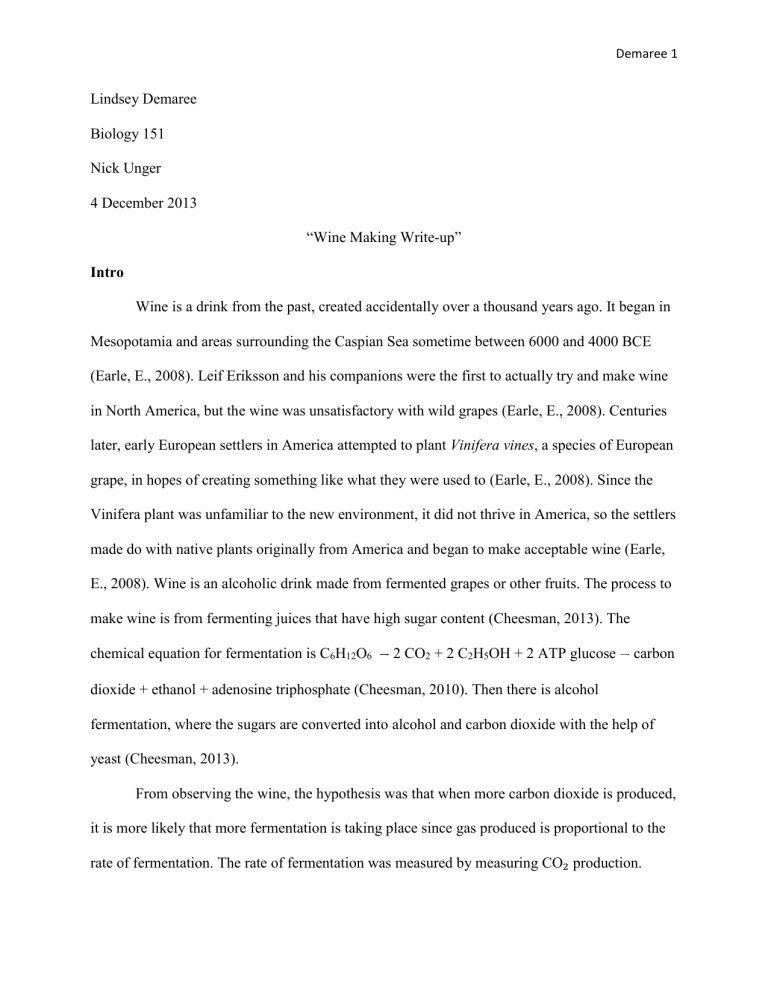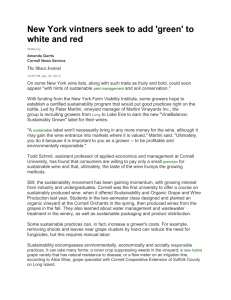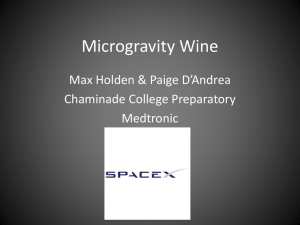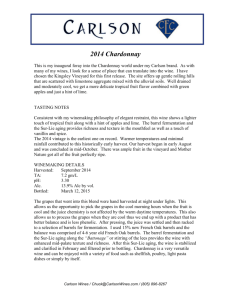File

Demaree 1
Lindsey Demaree
Biology 151
Nick Unger
4 December 2013
“Wine Making Write-up”
Intro
Wine is a drink from the past, created accidentally over a thousand years ago. It began in
Mesopotamia and areas surrounding the Caspian Sea sometime between 6000 and 4000 BCE
(Earle, E., 2008). Leif Eriksson and his companions were the first to actually try and make wine in North America, but the wine was unsatisfactory with wild grapes (Earle, E., 2008). Centuries later, early European settlers in America attempted to plant Vinifera vines , a species of European grape, in hopes of creating something like what they were used to (Earle, E., 2008). Since the
Vinifera plant was unfamiliar to the new environment, it did not thrive in America, so the settlers made do with native plants originally from America and began to make acceptable wine (Earle,
E., 2008). Wine is an alcoholic drink made from fermented grapes or other fruits. The process to make wine is from fermenting juices that have high sugar content (Cheesman, 2013). The chemical equation for fermentation is C
6
H
12
O
6
2 CO
2
+ 2 C
2
H
5
OH + 2 ATP glucose carbon dioxide + ethanol + adenosine triphosphate (Cheesman, 2010). Then there is alcohol fermentation, where the sugars are converted into alcohol and carbon dioxide with the help of yeast (Cheesman, 2013).
From observing the wine, the hypothesis was that when more carbon dioxide is produced, it is more likely that more fermentation is taking place since gas produced is proportional to the rate of fermentation. The rate of fermentation was measured by measuring CO ₂ production.
Demaree 2
Thicker juices, such as the carrot juice, did not ferment at the beginning of the wine making process. The carrot juice did not ferment as much because the sugar content was very low and did not produce as much CO ₂ as the other juices.
Methods
In order to start the wine making process, three 2 liter Erlenmeyer flasks were setup. In the first flask, 750 milliliters of the fruit juice was placed, in addition to 0.070 grams of wine making yeast. Different juices were used for the experiment were red grape, white grape, cherry, and carrot. Surgical tubing was placed from one bottle to another, so that CO ₂ would travel from one bottle to another. In the second bottle, there was 2 liters of water. As the middle flask filled up with CO ₂, the pressure pushed down on the water, and moved it to the third bottle, which started off empty. This is how CO
2
placement was determined.
Figure 1: Wine making apparatus
Graph 1
Demaree 3
Results
The results were that red grape and white grape had the most sugars per serving size, 36 grams. Cherry had 25 grams of sugars per serving and carrot had 10 grams of sugars per seving
(Graph 1). The calories per serving were as follows; cherry had the highest count for calories, in the lead with 160. Both red grape and white grape had 140 calories per serving. Carrot had the lowest calorie count, with 80 calories per serving (Graph 1).
Discussion
We determined the amount of displaced water by measuring the amount of water in the third flask, which started off empty. The type of fermentation that took place was alcohol fermentation. Alcohol fermentation is where the sugars are converted into alcohol and carbon dioxide with the help of yeast (Cheesman, 2013). The sugars in the fruit juices fermented and turned into alcohol.
Fruits, grains and dairy can all undergo fermentation, which results in either wine, beer, or cheese (Cheesman, 2013). Energy remains in these fermented products because they still contain sugars, also known as glucose. The type of gas we measured was carbon dioxide. We measured the CO
2
by how much gas the juice gave off during the fermentation process (Cheesman, 2013). When more CO
2 was produced, it was more apparent that fermentation was taking place (Cheesman, 2013). Cherry gave off the most carbon dioxide
(Graph 1). As you can see in Graph 1, cherry had a significant larger amount of calories per serving compared to the other juices. This is because of the large amount of CO
2
that was produced. The amounts of water displaced by CO ₂ were as follows; cherry had with 13,390 mL of displaced water. White grape had with 12,300 mL of displaced water. Then red grape had
10,910 mL of displaced water. Lastly, carrot had the least amount of displaced water, with 6,090 mL (Graph 2). In Graph 2, you can see that cherry had the highest amount of water displacement by CO
2
. Carrot, on the other hand, had the least amount of calories, sugars, and water
Demaree 4 displacement (Graph 1, Graph 2). This can be explained because carrot has a low sugar count, therefore it did not ferment as much as the other juices, such as cherry which fermented a lot by producing a large amount of CO
2
.
Demaree 5
References
Cheesman, K., Heym, K., Anderson, C. (2013) Inquiry, A Laboratory Manual for Foundations of
Modern Biology (2 ed.)(52-53). Acton, Massachusetts: Copley Publishing.
Earle, E. (2008). Exhibition. Song of the Vine, History of Wine. Retrieved from http://rmc.library.cornell.edu/ewga/exhibition/america/index.html





